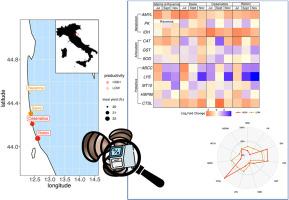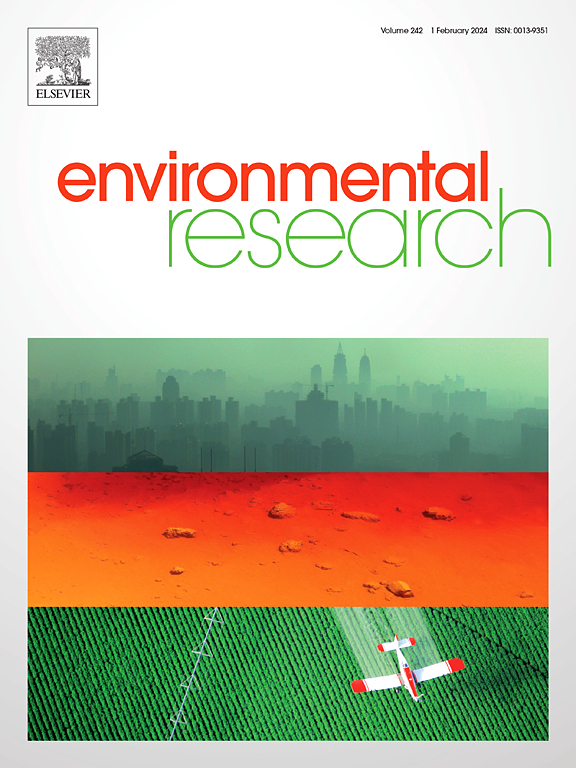Physiological plasticity and life history traits affect Chamelea gallina acclimatory responses during a marine heatwave
IF 7.7
2区 环境科学与生态学
Q1 ENVIRONMENTAL SCIENCES
引用次数: 0
Abstract
The striped venus clam (Chamelea gallina) is a relevant economic resource in the Adriatic Sea. This study explored the physiological status of C. gallina at four sites selected along a gradient from high to low incidence of recorded historical mortality events and low to high productivity in the Northwestern Adriatic Sea. Investigations were performed during the marine heatwave in 2022 (from July to November). The optimal temperature range for C. gallina was exceeded in July and September, exacerbating stress conditions and a poor nutritional status, particularly at the low productivity sites. Transcriptional profiles assessed in digestive glands showed that clams from the low productivity sites up-regulated transcripts related to feeding/digestive functions as a possible compensatory mechanism to withstand adverse environmental conditions. Clams from the high productivity sites, that in a previous study showed enrichment of health-promoting microbiome components, displayed a healthier metabolic makeup (IDH up-regulation) and induction of protective antioxidant and immune responses. These features are hallmarks of putative enhanced resilience of the species towards environmental stress. Despite the well-known high sensitivity of C. gallina to environmental variations and its narrow window of acclimatory potential, results highlight that local conditions may influence physiological plasticity of this clam species and shape either positively or negatively its response capabilities to environmental changes. The identification of health-promoting endogenous mechanisms both from the animal (this study) and from its associated microbiome may provide the foundation for developing novel tools and strategies to improve clam health and production in low productivity areas or under adverse environmental conditions.

生理可塑性和生活史特征影响五步蛇在海洋热浪中的适应性反应。
条纹文蛤(Chamelea gallina)是亚得里亚海的一种相关经济资源。本研究在亚得里亚海西北部从有历史记录的死亡事件高发地到低发地、从低生产力到高生产力的梯度上选定的四个地点,探讨了条纹文蛤的生理状态。调查是在 2022 年海洋热浪期间(7 月至 11 月)进行的。七月和九月的温度超过了 C. gallina 的最适温度范围,加剧了应激条件和营养状况,尤其是在低生产力地点。对消化腺转录谱的评估表明,低生产力地点的蛤蜊上调了与摄食/消化功能有关的转录本,这可能是一种抵御不利环境条件的补偿机制。在之前的一项研究中,高生产力地点的蛤蜊富含促进健康的微生物组成分,显示出更健康的新陈代谢结构(IDH 上调),并诱导保护性抗氧化和免疫反应。这些特征表明,该物种对环境压力的适应能力可能有所增强。尽管众所周知五倍子蛤对环境变化高度敏感,而且其适应潜力窗口很窄,但研究结果突出表明,当地条件可能会影响这种蛤类的生理可塑性,并对其应对环境变化的能力产生积极或消极的影响。从动物(本研究)及其相关微生物组中发现促进健康的内源机制,可为开发新的工具和战略奠定基础,以改善低生产力地区或不利环境条件下的蛤蜊健康和产量。
本文章由计算机程序翻译,如有差异,请以英文原文为准。
求助全文
约1分钟内获得全文
求助全文
来源期刊

Environmental Research
环境科学-公共卫生、环境卫生与职业卫生
CiteScore
12.60
自引率
8.40%
发文量
2480
审稿时长
4.7 months
期刊介绍:
The Environmental Research journal presents a broad range of interdisciplinary research, focused on addressing worldwide environmental concerns and featuring innovative findings. Our publication strives to explore relevant anthropogenic issues across various environmental sectors, showcasing practical applications in real-life settings.
 求助内容:
求助内容: 应助结果提醒方式:
应助结果提醒方式:


